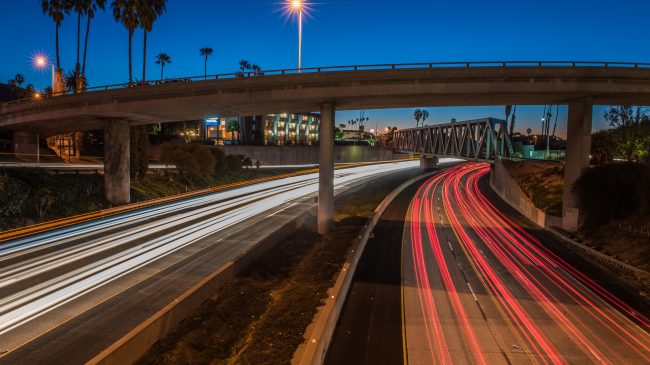Executive Summary
From “Managed Lanes Connecting Metro Areas: The Pragmatic Solution“
America’s Interstate Highway System is facing two major problems: congestion and lifespan. Traffic congestion continues to grow throughout the country. Originally occurring only during rush hour in urban corridors, many highways are now congested for up to 18 hours a day, every day of the week. Worse, many of these highways are not in urban or suburban locations but between metro areas, hampering mobility of people and goods. Freight vehicles must limit travel to certain time periods or travel circuitous routes to avoid congestion, limiting productivity and increasing shipping costs. With limited right-of-way, increasing material costs and neighborhood opposition to widening, it is not surprising that urban Interstate modernization projects have not kept pace with the growth in vehicle-miles traveled. But even outside of metro areas, an increasing number of Interstates have become congested for up to 10 hours per day. Travelers on these highways, which are too narrow for today’s traffic volumes, encounter traffic delays, safety problems, and decreased economic activity.
Further, most Interstate highways are reaching the end of their designated lifespan. While state departments of transportation (DOTs) have generally maintained Interstate pavement conditions through resurfacing, most of the foundation down to the roadbed itself is worn out. As a result, the different layers of the roadway need to be rebuilt starting with the roadbed. Rebuilding the Interstate Highway System is estimated to cost more than a trillion dollars.
Value-added tolling (VAT), which uses tolling to generate the revenue needed to rebuild the highways, is the most realistic way to pay for this reconstruction. The overall principle is to toll only when and where it creates a better deal for highway users than the status quo. Value-added tolling has five principles:
- Toll only after major improvements (modernization/reconstruction) are completed;
- Limit the use of toll revenues to the specific highway or highway system where they are collected;
- Charge only enough to cover the cost to build (or rebuild) the highway, maintain it, and improve and eventually rebuild its facilities;
- Use tolls to replace existing user taxes, not add to them; and
- Provide a better level-of-service (LOS—a measure of congestion) than what prevails on the highways where tolling is introduced.
Unfortunately, while acceptance for tolling selected lanes of a freeway is growing substantially, acceptance of tolling the entire roadway is more limited.
A near-term approach would be to add new express toll lanes to the facility without rebuilding the existing general lanes. This option is not ideal, as it delays needed reconstruction of the road forcing state departments of transportation (DOTs) to invest in pavement overlays to extend the life of the roadway. However, the option does have many advantages:
- The express toll lanes would provide an uncongested alternative that offers a consistent travel time for travelers who choose to pay a variable toll to bypass congestion;
- The express toll lanes would help reduce traffic in the general purpose lanes by providing new capacity;
- The express toll lanes would help increase reliability and therefore the popularity of intercity bus service. Buses operate on some of the most congested rural corridors. Unlike Amtrak rail, buses are not subsidized and offer many different types of service along the corridor;
- The express toll lanes would help familiarize travelers with 21st-century tolling technology and would increase the popularity of tolling; and
- The express toll lanes could be used to relieve traffic congestion when the rest of the highway is rebuilt.
This brief includes case studies of four corridors connecting metro areas that may be good candidates for managed lanes: I-5 in California between San Diego and Orange County, I-85 in North Carolina between Greensboro and Durham, I-95 in Connecticut between the New York state line and New Haven, and I-95 in Virginia between the Richmond and Washington, D.C. metro areas. The case studies include the location of the managed lanes, information on traffic accidents as well as congestion, historical information about the highway and future growth projections.
Building express toll lanes (ETLs) has proven to be a successful strategy for increasing mobility and reducing congestion. While most express toll lanes are located in metropolitan areas, growing congestion between metro areas offers an opportunity for innovative state DOTs to add ETLs outside metro areas as well. ETLs do more than increase mobility for cars; they offer semi-exclusive guideways for buses and vanpools. Managed lanes between metro areas provide a congestion-free guideway for intercity buses. Free from the congestion in the general purpose lanes, intercity buses would offer more convenient and quicker travel times, increasing the number of bus riders in these corridors.
While the best long-term solution is to rebuild the entire Interstate cross-section and toll all lanes, political realities may make that alternative challenging in the short to medium term. If rebuilding and tolling the highway is not feasible, adding new express toll lanes is an option for those willing to pay to bypass congestion in the general purpose (GP) lanes, and benefits transit users as well.
Full Study — Managed Lanes Connecting Metro Areas: The Pragmatic Solution

